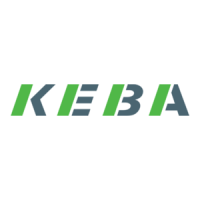13
Introduction to SERCOS interface
ServoOne User Manual SERCOS II and III
ID no.: 1108.26B.3-00 Date: 04/2020
Introduction to SERCOS interface
3 Introduction to SERCOS interface
3.1 Application and usage
SERCOS interface stands for SERial Realtime COmmunication System interface
and is a worldwide standardised (IEC61491 and EN61491) digital interface for the
communication between controllers, drives and other decentral peripherals. Due to
the real-time-critical transmission of reference values and actual values, numerically
controlled high-performance drive applications in mechanical engineering can be
realised.
Services for operation mode acquisition, setting parameters, conguration and
diagnostics are also available.
The real-time capability permits highly dynamic applications in drive technology with
NC cycle times from 125µs to 65ms (multiples of 125µs). The data to be transferred
are dened in the SERCOS driver in numerous preferred telegrams and parameters.
They are specially tailored to the high requirements of electrical drive systems. A freely
congurable telegram permits the optimal exploitation of system features by means of
additional reference values and actual value parameters, e.g. increasing the position
resolution to be transferred, usage of the inputs and outputs available in the drive in the
NC cycle, and much more.
3.2 Key features
3.2.1 SERCOS II
y Data transfer via plastic optical bre cable (POF) or hard clad silica cable
(HCS) using F-SMA connectors
y Transfer rate: either 2, 4, 8 or 16 MBaud
y Automatic baud rate detection
y Adjustable transmit power via DIP switches (only hardware variant 1),
otherwise via parameters. Setting via buttons and display in preparation
y SERCOS address can be set via parameters
3.2.2 SERCOS II and SERCOS III
y Cyclic exchange of reference values and actual values with exactly equal
timing
y SERCOS cycle time from 125µs to 65ms (can be set to multiples of 125µs)
y Multiple axis synchronisation between the time the reference value becomes
effective and the time the actual values are measured on all drives in a ring
y Complete synchronisation of all drives connected to the controller
y Telegram contents can be congured as required
y Maximum number of items of data that can be congured in the MDT:
20 bytes
y Maximum number of items of data that can be congured in the AT: 20 bytes
y Adjustable parameter weighting and polarity for position, speed, acceleration
and torque
y Additive speed and torque reference values
y Fine, drive-internal interpolation (linear or cubic)
y Either controller-side (external) or drive-internal generation of the speed and
acceleration feed forward
y Service channel for setting parameters and diagnostics
y Support for touch probe 1 and 2
y Support for spindle commands
y Support for congurable real-time status bits and real-time control bits
y Support for congurable signal status word and signal control word
3.2.3 SERCOS III
y Third generation of the Sercos interface series
y Data transfer via Ethernet IEEE 802.3
y SERCOS address can be set via parameters
y NRT/IP channel available

